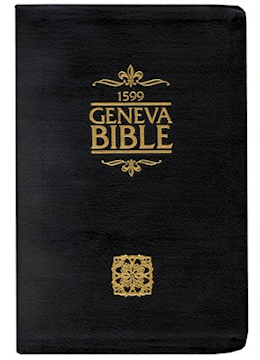Textus Receptus Bibles
Geneva Bible 1560/1599
| 31:1 | Now the Philistims fought against Israel, and the me of Israel fled away from ye Philistims, and they fell downe wounded in mount Gilboa. |
| 31:2 | And the Philistims preassed sore vpon Saul and his sonnes, and slewe Ionathan, and Abinadab, and Malchishua Sauls sonnes. |
| 31:3 | And when the battel went sore against Saul, the archers and bowmen hit him, and hee was sore wounded of the archers. |
| 31:4 | Then saide Saul vnto his armour bearer, Drawe out thy sworde, and thrust mee through therewith, lest the vncircumcised come and thrust me through and mocke me: but his armour bearer would not, for hee was sore afraid. Therefore Saul tooke a sworde and fell vpon it. |
| 31:5 | And when his armour bearer sawe that Saul was dead, he fell likewise vpon his sword, and dyed with him. |
| 31:6 | So Saul dyed, and his three sonnes, and his armour bearer, and all his men that same day together. |
| 31:7 | And when the men of Israel that were on the other side of the valley, and they of the other side Iorden saw that the men of Israel were put to flight, and that Saul and his sonnes were dead, then they left the cities, and ran away: and the Philistims came and dwelt in them. |
| 31:8 | And on the morowe when the Philistims were come to spoyle them that were slaine, they founde Saul and his three sonnes lying in mount Gilboa, |
| 31:9 | And they cut off his head, and stripped him out of his armour, and sent into the land of ye Philistims on euery side, that they should publish it in the temple of their idoles, and among the people. |
| 31:10 | And they layed vp his armour in the house of Ashtaroth, but they hanged vp his body on the wall of Beth-shan. |
| 31:11 | When the inhabitants of Iabesh Gilead heard, what the Philistims had done to Saul, |
| 31:12 | Then they arose (as many as were strong men) and went all night, and tooke the body of Saul, and the bodies of his sonnes, from the wall of Beth-shan, and came to Iabesh, and burnt them there, |
| 31:13 | And tooke their bones and buried them vnder a tree at Iabesh, and fasted seuen dayes. |

Geneva Bible 1560/1599
The Geneva Bible is one of the most influential and historically significant translations of the Bible into English, preceding the King James translation by 51 years. It was the primary Bible of 16th century Protestantism and was the Bible used by William Shakespeare, Oliver Cromwell, John Knox, John Donne, and John Bunyan. The language of the Geneva Bible was more forceful and vigorous and because of this, most readers strongly preferred this version at the time.
The Geneva Bible was produced by a group of English scholars who, fleeing from the reign of Queen Mary, had found refuge in Switzerland. During the reign of Queen Mary, no Bibles were printed in England, the English Bible was no longer used in churches and English Bibles already in churches were removed and burned. Mary was determined to return Britain to Roman Catholicism.
The first English Protestant to die during Mary's turbulent reign was John Rogers in 1555, who had been the editor of the Matthews Bible. At this time, hundreds of Protestants left England and headed for Geneva, a city which under the leadership of Calvin, had become the intellectual and spiritual capital of European Protestants.
One of these exiles was William Whittingham, a fellow of Christ Church at Oxford University, who had been a diplomat, a courtier, was much traveled and skilled in many languages including Greek and Hebrew. He eventually succeeded John Knox as the minister of the English congregation in Geneva. Whittingham went on to publish the 1560 Geneva Bible.
This version is significant because, it came with a variety of scriptural study guides and aids, which included verse citations that allow the reader to cross-reference one verse with numerous relevant verses in the rest of the Bible, introductions to each book of the Bible that acted to summarize all of the material that each book would cover, maps, tables, woodcut illustrations, indices, as well as other included features, all of which would eventually lead to the reputation of the Geneva Bible as history's very first study Bible.